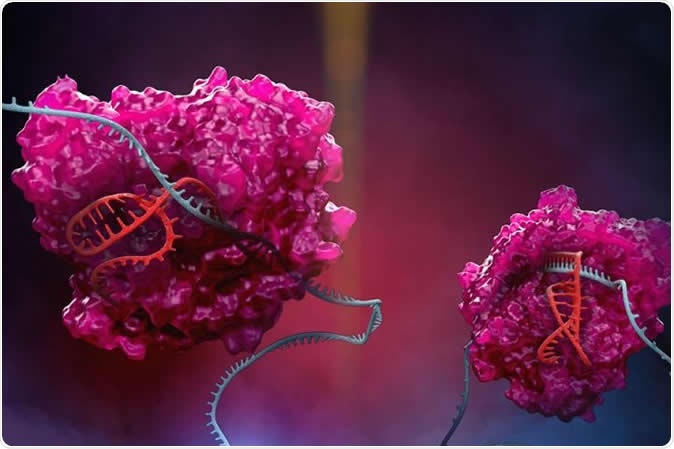CRISPR-based tools helped revolutionize the ability to target genetic mutations linked to disease development. Such tools focus on using the enzymes Cas9 and Cas12 to target DNA, and Cas13 to target RNA. Now, scientists used a new CRISPR platform that expands the capabilities of RNA editing.
A team of scientists at the McGovern Institute for Brain Research at the Massachusetts Institute of Technology (MIT) used a novel tool, dubbed as RESCUE (RNA Editing for Specific C to U Exchange), to create RNA edits that were not previously possible.
Published in the journal Science, the study could pave the way to formulate new treatment strategies for diseases such as Alzheimer’s disease, which affects more than 5 million people in the United States alone.

The CRISPR family enzyme Cas13 at work. Cas13 (pink), is at the heart of the RESCUE platform, where it uses a special guide (red) to target RNAs in the cell (blue). Image Credit: Stephen Dixon / Shutterstock
RESCUE expands the area that CRISPR can target
Feng Zhang, who is a pioneer of CRISPR technology at the Broad Institute in MIT, and his co-authors of the study, developed RESCUE.
The team used a deactivated Cas13 to guide RESCUE to targeted cytosine bases on RNA transcripts and used a new and programmable enzyme to convert unwanted cytosine into uridine, hence making changes in RNA instructions. RESCUE builds on the team’s existing REPAIR (RNA editing for programmable A to I (G) replacement) platform that converts Cas13-targeted adenine residues to inosine.
RESCUE markedly expands the area that CRISPR tools can focus on, including modifiable positions in proteins, like phosphorylation sites. These sites play the role of switches for protein activity and they are in signaling molecules and cancer-associated pathways.
"To treat the diversity of genetic changes that cause disease, we need an array of precise technologies to choose from,” Prof. Zhang, professor of neuroscience at MIT, said in a statement.
“By developing this new enzyme and combining it with the programmability and precision of CRISPR, we were able to fill a critical gap in the toolbox,” he added.
RESCUE implications
There are new targets in site for the use of RESCUE’s expanded targeting. Now, with the new technology, scientists can target sites that regulate the activity and function of various proteins through post-translational changes, including glycosylation, phosphorylation, and methylation, for easier editing.
RNA editing has a major advantage, and that it’s reversible, compared to changes performed at the DNA level, which are considered permanent. Hence, RNA editing through RESCUE can be used in situations where modification is needed temporarily, but not permanently.
To demonstrate this, the team used RESCUE to target specific sites in human cells, particularly the RNA encoding β-catenin, which are known to be phosphorylated on the protein product. This leads to a temporary increase in the activation of β-catenin and subsequent cell growth.
If the tool modified it permanently, it could lead to uncontrolled cell growth and eventually, cancer. But, when they used RESCUE, which performed just temporary edits, transient cell growth could possibly trigger wound healing when faced with acute injuries.
RNA editing also reduces concerns about DNA editing, how it can be harmful if it misses a target since it causes permanent modifications. RNA editing, on the other hand, offers temporary effects, so it can modulate a person’s genes temporarily to improve health.
“It's almost like a small, pill-like version of gene therapy,” Omar Abudayyeh, co-author of the study said.
Possible Alzheimer’s disease treatment approach
The researchers also showed that they can edit a gene called APOE4. Using Cas13, the team took APOE4, which is believed to carry the risk of developing Alzheimer’s and edited it to become a benign APOE2.
The research shows promise in new potential treatment options for people with brain disorders, including dementia and Alzheimer’s disease. The researchers, however, caution that the study in cells is in very early stages and needs further development.
“It's the first step in a very large journey. We're still at the base of the mountain, you might say,” a Jonathan Gootenberg, a researcher at MIT’s McGovern Institute, said.
The researchers, however, emphasized that RNA editing shows promise, specifically for potential use in brain disorders. The experiment performed on the Alzheimer’s-linked gene is a demonstration of the novel technology’s power. The gene is a well-known precursor in developing debilitating and fearful disease.
To broaden the use of RESCUE, the researchers plan to share the tool to others, just like what they did to other CRISPR tools they’ve developed. In fact, the technology is available for free for academic research through Addgene, a non-profit plasmid repository.
Journal reference:
A cytosine deaminase for programmable single-base RNA editing, Omar O. Abudayyeh, Jonathan S. Gootenberg, Brian Franklin, Jeremy Koob, Max J. Kellner, Alim Ladha, Julia Joung, Paul Kirchgatterer, David B. T. Cox, Feng Zhang, Science 26 Jul 2019: Vol. 365, Issue 6451, pp. 382-386, DOI: 10.1126/science.aax7063, https://science.sciencemag.org/content/365/6451/382